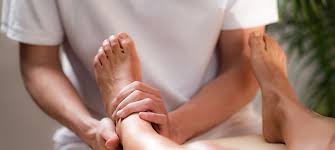Massage therapy is often seen as a luxury or relaxation tool, but in the world of professional athletics, it plays a crucial and hidden role in athletes’ recovery and performance. Beyond simply easing muscle soreness, massage therapy has a significant impact on injury prevention, rehabilitation, and overall performance enhancement. Let’s dive into the hidden role of massage therapy in professional athletes’ recovery and how it’s integrated into their training routines.
1. Muscle Recovery and Repair
Professional athletes put their bodies through extreme physical exertion, which can lead to muscle damage and micro-tears during intense training or competition. Massage therapy helps accelerate the recovery process by increasing blood flow to the muscles, which delivers essential nutrients and oxygen that promote healing.
It also helps to reduce lactic acid build-up, which can cause muscle fatigue and soreness. By aiding in muscle recovery, massage therapy can reduce the time needed for muscles to repair and regenerate after a strenuous workout or match.
2. Injury Prevention
While massage therapy is often used for recovery, it is also a vital tool in preventing injuries. Regular massage can help identify and address muscle imbalances, tension, and tightness before they lead to more serious injuries.
By maintaining flexibility and ensuring muscles are in optimal condition, athletes are less likely to experience strains, sprains, or other injuries that could sideline them during a season. Specific techniques, like deep tissue massage, help release knots and relieve muscle stiffness, which can lead to better range of motion and a lower risk of overuse injuries.
3. Enhanced Circulation
Massage improves blood circulation, which is essential for an athlete’s recovery and overall performance. Increased circulation helps remove metabolic waste products, such as lactic acid and other toxins, that accumulate in muscles after intense exertion. At the same time, the improved flow of blood helps deliver oxygen and nutrients to muscles, speeding up the repair process and reducing fatigue. For athletes, this means a faster recovery and the ability to train more effectively.
4. Reducing Stress and Mental Fatigue
The mental aspect of an athlete’s performance is just as important as their physical conditioning. Stress, anxiety, and mental fatigue can affect an athlete’s concentration and focus, leading to subpar performances. Massage therapy provides a relaxing environment that reduces stress hormones (like cortisol) and increases the production of endorphins, which are natural mood boosters. This can help athletes feel more mentally refreshed and prepared for training or competition.
5. Improved Flexibility and Range of Motion
Flexibility plays a major role in an athlete’s ability to perform specific movements efficiently and without injury. Tight muscles can restrict movement, which in turn affects an athlete’s performance. Massage therapy, particularly techniques like stretching and myofascial release, can significantly improve flexibility and range of motion. This allows athletes to move more freely, execute more precise movements, and reduce their risk of injury during performance.
6. Pain Management and Chronic Conditions
Many professional athletes deal with chronic pain or recurring injuries from years of high-level competition. Conditions like tendinitis, IT band syndrome, and chronic lower back pain are common among athletes. Regular massage therapy can serve as a non-invasive pain management tool by increasing circulation to the affected areas, reducing inflammation, and promoting tissue healing. It can also act as a complementary therapy to medical treatment, providing relief and improving an athlete’s quality of life.
7. Post-Competition Recovery
After an intense competition or training session, an athlete’s body is often in a heightened state of tension and stress. Massage helps to calm the nervous system and encourage relaxation, speeding up the transition from a state of exertion to recovery. Many professional athletes use massage therapy as part of their post-event routine to recover more quickly, avoid muscle stiffness, and reduce the chances of experiencing delayed onset muscle soreness (DOMS). This is especially important during tournaments or seasons where recovery time is limited between events.
8. Mental Focus and Preparation for Performance
Massage therapy isn’t just about recovery; it also helps athletes mentally prepare for competition. A well-timed massage session before a big game or event can help athletes focus by reducing mental distractions and promoting relaxation. This allows them to enter the competition with a clear mind, reduced anxiety, and a heightened sense of awareness. In sports like tennis, golf, or football, where mental sharpness is critical, massage therapy can play a pivotal role in enhancing focus and concentration.
9. Integration into Recovery Routines
Massage therapy is often integrated into a larger recovery routine that includes ice baths, stretching, physiotherapy, and rest. Professional sports teams and athletes typically employ a team of therapists, including massage specialists, to work alongside coaches, doctors, and trainers to provide a holistic approach to recovery. For athletes, this integration means having access to a variety of tools that work together to optimize recovery and reduce the risk of overtraining or injury.
10. The Role of Massage in Long-Term Athlete Health
As athletes age or as their careers progress, maintaining physical health becomes more challenging. Massage therapy can help prolong careers by aiding in the prevention and management of long-term injuries. Regular sessions can maintain mobility, reduce wear and tear on joints, and help athletes stay at their physical peak for longer. In fact, many top athletes in sports like football, tennis, and basketball credit massage therapy as a key component in their ability to extend their careers and perform at a high level into their 30s or even 40s.
Massage therapy plays a multifaceted role in professional athletes’ recovery that extends far beyond the common perception of simply “relaxing the muscles.” From injury prevention and pain management to enhanced circulation, flexibility, and mental relaxation, massage therapy has become an essential part of modern athletic care.
When used strategically, it allows athletes to recover faster, perform better, and sustain a longer, healthier career. With its proven benefits, massage therapy will continue to be an integral component of professional sports, contributing to an athlete’s overall well-being and peak performance.

